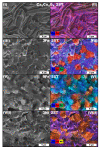Prospects for Electrical Performance Tuning in Ca3Co4O9 Materials by Metallic Fe and Ni Particles Additions
- PMID: 33669648
- PMCID: PMC7922274
- DOI: 10.3390/ma14040980
Prospects for Electrical Performance Tuning in Ca3Co4O9 Materials by Metallic Fe and Ni Particles Additions
Abstract
This work further explores the possibilities for designing the high-temperature electrical performance of the thermoelectric Ca3Co4O9 phase, by a composite approach involving separate metallic iron and nickel particles additions, and by employing two different sintering schemes, capable to promote the controlled interactions between the components, encouraged by our recent promising results obtained for similar cobalt additions. Iron and nickel were chosen because of their similarities with cobalt. The maximum power factor value of around 200 μWm-1K-2 at 925 K was achieved for the composite with the nominal nickel content of 3% vol., processed via the two-step sintering cycle, which provides the highest densification from this work. The effectiveness of the proposed approach was shown to be strongly dependent on the processing conditions and added amounts of metallic particles. Although the conventional one-step approach results in Fe- and Ni-containing composites with the major content of the thermoelectric Ca3Co4O9 phase, their electrical performance was found to be significantly lower than for the Co-containing analogue, due to the presence of less-conducting phases and excessive porosity. In contrast, the relatively high performance of the composite with a nominal nickel content of 3% vol. processed via a two-step approach is related to the specific microstructural features from this sample, including minimal porosity and the presence of the Ca2Co2O5 phase, which partially compensate the complete decomposition of the Ca3Co4O9 matrix. The obtained results demonstrate different pathways to tailor the phase composition of Ca3Co4O9-based materials, with a corresponding impact on the thermoelectric performance, and highlight the necessity of more controllable approaches for the phase composition tuning, including lower amounts and different morphologies of the dispersed metallic phases.
Keywords: composite approach; controlled interactions; electrical performance; thermoelectric cobaltites; transition metals additions.
Conflict of interest statement
The authors declare no conflict of interest. The funders had no role in the design of the study; in the collection, analyses, or interpretation of data; in the writing of the manuscript, or in the decision to publish the results.
Figures










References
-
- Freer R., Powell A.V. Realising the potential of thermoelectric technology: A Roadmap. J. Mater. Chem. C. 2020;8:441–463. doi: 10.1039/C9TC05710B. - DOI
-
- Bahrami A., Schierning G., Nielsch K. Waste Recycling in Thermoelectric Materials. Adv. Energy Mater. 2020;10 doi: 10.1002/aenm.201904159. - DOI
-
- Beretta D., Neophytou N., Hodges J.M., Kanatzidis M.G., Narducci D., Gonzalez M.M., Beekman M., Balke B., Cerretti G., Tremel W., et al. Thermoelectrics: From history, a window to the future. Mater. Sci. Eng. R Rep. 2019;138 doi: 10.1016/j.mser.2018.09.001. - DOI
-
- Patil D.S., Arakerimath R.R., Walke P.V. Thermoelectric materials and heat exchangers for power generation—A review. Renew. Sustain. Energy Rev. 2018;95:1–22. doi: 10.1016/j.rser.2018.07.003. - DOI
-
- Champier D. Thermoelectric generators: A review of applications. Energy Convers. Manag. 2017;140:167–181. doi: 10.1016/j.enconman.2017.02.070. - DOI
Grants and funding
LinkOut - more resources
Full Text Sources
Other Literature Sources

